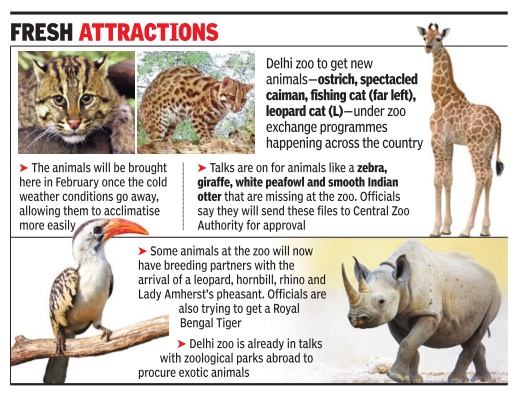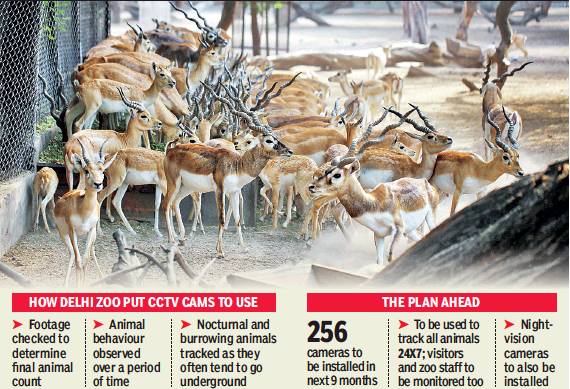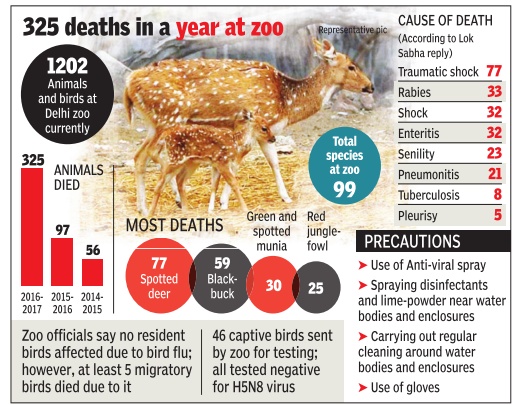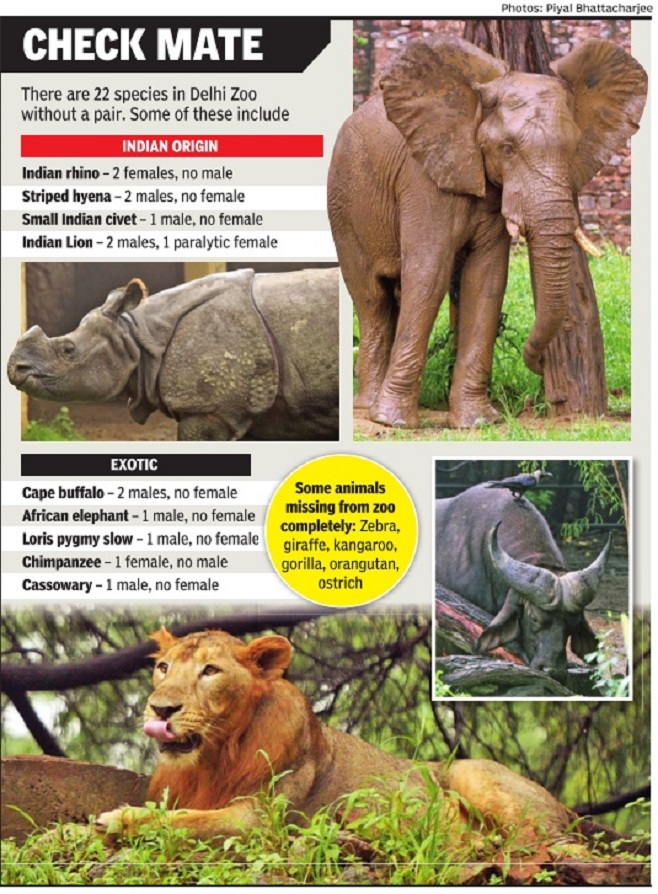Delhi Zoo
This is a collection of articles archived for the excellence of their content. |
Contents[hide] |
Zoo (National Zoological Park)
Attractions in the zoo
2017 November, animals in the zoo

From: November 7, 2017: The Times of India
See graphic:
Attractions in Delhi Zoo, November 2017
Census
2019: CCTVs helped
Jasjeev Gandhiok, June 19, 2019: The Times of India

From: Jasjeev Gandhiok, June 19, 2019: The Times of India
CCTV cameras are in much use at Delhi’s National Zoological Park these days. They have helped the zoo authorities to finally carry out the census of animals ordered by Delhi high court in April, and will now be installed in enclosures to keep tabs on not only the animals, but also the staff and the visitors.
CCTV cameras were uniquely used for the first time to determine the number of zoo animals, particularly nocturnal and burrowing animals which the zoo authorities said could have been hard to track if normal procedures for counting were followed.
The high court had ordered completion of the census within two weeks, but the results were delayed all this while. “We wanted to carry out a comprehensive audit, and so the delay,” Renu Singh, director, Delhi zoo, told TOI. “We studied CCTV footage and determined the number of burrowing animals that had gone underground. CCTV cameras also helped us detect a fox birth that we had not seen earlier.”
According to officials, 13 CCTV cameras were used interchangeably at different enclosures for the census. They were also used to number the deer population at the zoo. “Since there is a large number of deer and they are in one large enclosure, we used CCTV cameras to arrive at their exact number,” said Singh.
The recorded footage also yielded information on the feeding patterns and the behaviour after lights went off of certain animals such as jackals and monitor lizards. This boost to information collection has inspired the zoo to install 256 CCTV cameras by the end of the financial year.
The Rs 5-crore project is aimed at keeping track of animals, zoo staff and to ensure visitors do not violate rules. “We will know more about our staff, their whereabouts, what visitors are doing and where a particular animal is located at any point of time. Instances of visitors throwing items in the enclosures, like in the past, can also be tracked,” explained Singh.
Delhi high court rapped the zoo for irregularities in animal data and irregularities in post-mortem reports and finances. On April 9, it directed the zoo to carry out an animal census and even granted police protection after the zoo officials pleaded that its own staff was obstructing the count. The court observed, “There is absolute lawlessness prevailing in the national zoo of the country… The records are being manipulated and tampered with, and the statutory body is not being allowed to perform its assigned duties. The death of animals is being suppressed.”
The court added that the lack of action by the ministry of environment, forests and climate change following the Central’s Zoo Authority’s 2016 reports had led to the deteriorating situation in Delhi zoo.
Chimpanzees
57-year-old in Record Books/ 2019
Delhi zoo’s oldest chimpanzee, 57-year-old Rita, has now been recognised as the oldest chimpanzee in the country, according to the Limca Book of Records. Rita came from Amsterdam zoo as part of an exchange of demoiselle cranes in 1964. She was inducted in the record book on Thursday, with the certificate stating, “Rita, an inmate of Delhi zoo is India’s oldest chimpanzee and probably the oldest in Asia.”
Delhi 11 zoo director Renu Singh said the zoo had applied for the certification last year and the confirmation was received earlier this month. The Limca Book of Records carried out the basic record checks across zoological parks in the country before confirming. “Most chimpanzees don’t live beyond the age of 50 with their lifespan ranging from 40 to 50 years. Rita has lived well past that and continues to flourish here,” said Singh.
Rita became a star attraction in 2017 when zoo visitors celebrated her birthday, which included a cake-cutting ceremony. Cut-outs of Rita and a large display screen had been put outside her enclosure, showcasing her each move.
Rita was paired with a male chimpanzee Max at Delhi zoo. She was loaned to Chhatbir zoo in Punjab in 1985 but returned to the Delhi zoo again in 2006.
Deaths of animals
2014-17
See graphic: Animal deaths in Delhi zoo, 2014-17, year-wise

Of the 325 deaths recorded at Delhi zoo in 2016-17, more than 100 cases were due to traumatic shock -that is, shock in captivity . Also, it was the first time in six years that over 300 animals had died in a single year.
A day after Union environment minister Harsh Vardhan informed the Lok Sabha about the high mortality, TOI did a reality check to find that unlike the previous year, rabies and bird flu weren't the biggest culprits this time. While 33 cases of rabies were reported, not a single death took place due to bird flu.
“Forty-six resident birds that died last year were sent for testing for H5N8 virus.However, all tests came out negative. We could not find out the actual cause of death as postmortem wasn't conducted at the zoo. At least five positive cases of bird flu were reported last year, but all these involved migratory birds,“ said a zoo official.
In fact, the total number of deaths recorded last year was greater than the combined figure of the three years prior to that. The zoo recorded 97 deaths in 2015-16; 56 in 2014-15; and 103 in 2013-14.
As many as 77 spotted deer deaths were recorded in 2016-17; 33 of these occurred due to rabies.
Another 59 blackbuck -a Schedule-I animal under the Widlife Protection Act, 1972 -died, several of them dying due to pneumonitis, an inflammation of lungs.
A total of 109 cases related to `traumatic' shock that, zoo officials said, might occur when the ani mal was stressed or faced with extreme weather conditions. “Animals, especially deer, often fight among themselves to show superiority. This sometimes causes shock,“ said a zoo official.
In addition, 23 deaths were reported due to senility, 32 because of enteritis, 21 due to pneumonitis and eight owing to tuberculosis.
The zoo also lost all four of its monitor lizards, which were `pulled' out during hibernation, leading to shock.An exotic African cape buffalo died due to tuberculosis.
Zoo authorities said they were taking precautions. “We are regularly cleaning the enclosures and using anti-viral spray for animals. We are using disinfectants for ponds and workers have been asked to use gloves,“ said Renu Singh, director, Delhi zoo.
Attractions in Delhi Zoo, November 2017
Footfalls
Records
Delhi zoo saw a record footfall of close to 34,500 visitors January 1, 2018 beating its previous record by over 2,000 people. Earlier, the highest footfall recorded on a single day was 32,006. Zoo officials said 34,352 visitors came to the zoo on January 1, 2018, despite foggy conditions and low mercury. In 2017, the zoo recorded a footfall of 31,414 visitors on Eid.
Monuments within the campus
Unmarked tomb
The Times of India, August 11, 2015

Little is known about the tomb, historians say it was an early Mughal-era structure, one of the many that can be found in the area. It is not a listed monument, and decades of neglect have led its ornamentation and geometric patterns to wither away completely. The masonry of the dome is exposed, with creepers trailing all over it. Many stones on the edges seem to rest loosely, ready to fall on anyone standing underneath./// The tomb is close to a black bear enclosure on a raised ground near a waterbody .While zoo authorities have installed a signboard telling visitors to keep out. It has been done in a seemingly perfunctory manner. This sole board has been placed in a corner less frequented by people, and there are no railings or barriers which ideally should have been there considering it's a crumbling building.
Reptile house
2019: improvements

From: Jasjeev Gandhiok, All that slithers, you can see here: Reptile house to wow visitors, April 2, 2019: The Times of India
GLASS WALLS, FUN FACTS AT NEW-LOOK ENCLOSURES AT ZOO
Delhi zoo threw open a revamped reptile house for visitors, which will showcase the different types of reptiles found across the country. Opened after almost six months, the entire area has been given a complete makeover, making it disabled-friendly.
Large glass walls and additional lighting have also been installed at the reptile house, with each enclosure having descriptive boards and fun facts about the species present inside. “The idea is to make the entire area more interactive. Each enclosure now has large glass walls, with informative boards so that people know more about the reptiles they are viewing, what they eat and where they are found,” said zoo director Renu Singh.
The access area to the reptile house, which is located behind the white-tiger enclosure, has also been made disabled-friendly. Zoo officials said the problem of suffocation inside the reptile house has been fixed by installing air-based turbines. “Earlier there were openings for sunlight, but the enclosures were quite airtight. Special vents have now been created with turbines installed on the top of the enclosure, which automatically balance the amount of air in the reptile house,” said an official.
Delhi zoo has already begun a drive to procure a number of reptiles for the house, which will include a few snake species that were lost recently. In addition to snakes, mountain lizards, water mountain lizards and different tortoise species will also be added.
At present, the reptile house has an Indian cobra, rat snakes, diadem snakes, water snakes, python, star tortoise and a red-eared tortoise. “We have started the process to acquire more reptiles. Snakes that died over the last few years will also be procured,” said zoo curator, Riyaz Khan.
To give visitors an interactive experience, Delhi zoo has planned a mini-desert safari, which will have a walking path with desert animals on either side. The path will pass through tunnels and a bridge as well, said an official.
